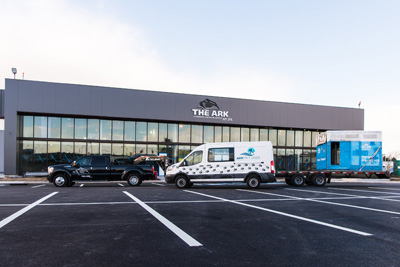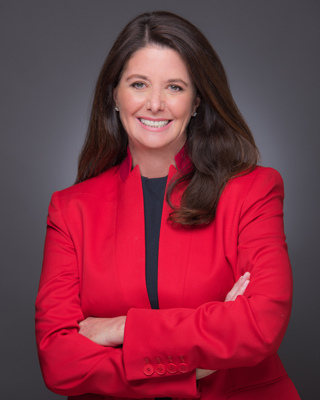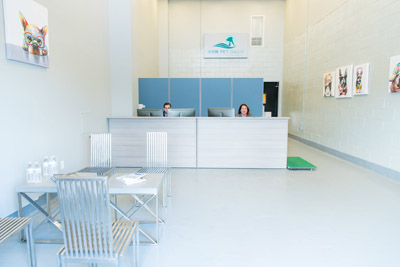
Facade of The ARK at JFK
Airport meditation rooms, massage chairs and bars soothe weary travelers and calm anxious passengers. Shopping, dining and Wi-Fi satisfy impulse buys, hunger and boredom. Options are nearly limitless for human passengers while horses, pets and other animals are limited in choices for passing the time before take-off.
Unless, those animals are transported through New York’s John F. Kennedy International Airport (JFK).
The once vacant cargo Building 78 is now a stateof- the-art facility with round-the-clock service specially designed for handling incoming and outgoing animals.
Operating as The ARK at JFK, the one-stop shop for animal air travel provides luxurious accommodations, top-notch veterinary care and rejuvenating services such as hand-walking and massage services for horses and a spa-like atmosphere for companion pets.
“There’s nothing else like it in the US,” said ARK Managing Director, Elizabeth A. Schuette.

John J. Cuticelli, Jr.
In February, ARK Development, LLC, a subsidiary of Racebrook Capital, unveiled phase one—the ARK Pet Oasis, the Equine and Livestock Export Center and the Aviary In- Transport Quarantine.
By the end of June, phase two—the full-service ARK Import- Export Center (“IEC”) featuring Equine Quarantine/Import, Grooms’ Lounge and The ARK Aviary will open. Before the year’s out, phase three will be operational and will include a full veterinary clinic, a veterinary blood laboratory and pet boarding and grooming facility. A cattle export area is planned for the future.
“We developed The ARK concept to address the unmet needs for the import and export of companion, sporting and agricultural animals,” says John J. Cuticelli, Jr. CEO, Racebrook and Founder and Chairman of ARK Development/The ARK at JFK.
The ARK is the only privately owned facility of its kind in the world. It is modeled after the Heathrow Animal Reception Center (HARC) and the Lufthansa Cargo Animal Lounge in Frankfurt, Germany, which offer similar services. Both are government owned facilities.
“Our goal is to create a more efficient and safe process by reducing the need for additional travel and offering trained animal care staff immediately pre- and post-flight,” Cuticelli said.

Animal Care Pre and Post Flight
Years in the making
Five years ago, JFK released a Request For Proposal (RFP) for an animal- care facility at the airport.
The RFP called for companies with a unique combination of veterinary, real estate and air cargo expertise to submit bids on the project. Cuticelli, the CEO of Racebrook Capital and his wife, Schuette, had all three.
Previously, Cuticelli acquired the facility now known as the Cornell Ruffian Equine Specialists located in Elmont, New York. The property, which is adjacent to the Belmont Race Track is an equine hospital that includes a surgical center. He acquired the functionally obsolete equine surgery center, and together with the expertise of Cornell University’s College of Veterinary Medicine, re-positioned the hospital into a leading international destination for equine welfare.
Prior to taking on responsibilities at The ARK, Schuette served as managing director with Racebrook Capital. She is a licensed real estate broker in Connecticut, Rhode Island and Florida. She is also President of George Washington Mortgage & Investment Corp. – a closely held boutique firm that manages real estate assets in New York and Maryland. In addition to her business background, her childhood connection to horses gave her first-hand experience in preparing horses for transportation.

Elizabeth A. Schuette
“My grandfather, a dentist in Manitowoc, Wisconsin, owned and raced horses. He had trotters and pacers that competed in harness racing throughout the Midwest and even at Yonkers racetrack,” she said. “I used to accompany my grandfather to county fairs in Wisconsin and Illinois.”
Cuticelli and Schuette’s collective breadth and diversity of expertise made the ARK a perfect fit. Most importantly, they understood the value of working with a world-class team of veterinarians, bio-chemists, architects, engineers and other professionals to accomplish the planning and construction of the advanced facility.
“The ARK has spared no expense in meeting and going well above USDA requirements to add even more comfort and safety for the horses and the other animals,” said Bill Nichols of the Alex Nichols Agency, a national and international horse transportation company that has already moved horses through the ARK.
Raising the bar
The ARK provides a healthy, biosecure and comfortable environment and sets new international airport standards for comprehensive veterinary, kenneling and quarantine services. The United States Department of Agriculture (USDA) sets forth specific regulations governing the export and import of all animals.
The export side is fairly simple. Horses leaving the US, arrive by trailer on the “landside” of the facility and are taken into the export area which contains 23 stalls that are 12’ x 12.’ Each stall has an open mesh front so that staff, vets and USDA officials can observe the horses easily. The export space is also equipped with a vet area with stocks/scales to “check-in” the horses and confirm paperwork, conduct any required pre-flight tests and check vital signs.
The ARK provides a calm, quiet environment where a horse can receive the USDA mandated six hours of rest prior to departure.

Rendering of the disinfecting foot bath
“They are fed high-quality timothy hay in deeply bedded stalls. We play classical music to help them relax and we switch to a country station when the reining and western horses arrive,” said Kristen M. McGowan, director of administration at the ARK.
The import side of the facility is more complex.
“The horses arrive “airside” and are unloaded from the jet stall into a receiving area where the horses are walked through a disinfecting foot bath, vital signs and blood are taken and then they proceed to their quarantine stall,” said Lachlan Oldaker, an Oklahoma architect that specializes in equine facilities and collaborated on this project.
Although she doesn’t have much time to ride and compete these days, she’s no stranger to the show pen and knows the amenities important to show horse owners. In 1974, she piloted Pit Bar Lucky to a Quarter Horse Congress Championship title in the Youth Jumping. In 1978, she won an American Junior Quarter Horse Association World Championship title in Working Hunter.
Beyond the disinfecting process, Oldaker designed a layout that separates incoming from outgoing horses. The import stalls are designed to serve as an isolation stall and each has its own ante room to store supplies and equipment for each individual horse. The ante room includes a water hook-up for filling buckets and cleaning operations along with storage for hay, bedding and feed used during the horse’s stay.

Dog Run View
“The quarantine stalls are individually climate controlled so there is no risk of cross contamination of air between horses,” she added.
Each stall is equipped with dimmers so the light levels can be adjusted if required.
The 48 quarantine stalls are surrounded by a “racetrack” ring that can be used for hand-walking the horses while in quarantine if the owner desires. Horses aren’t the only ones subject to biosecurity prevention procedures.
“Since the Import or Quarantine area is a bio-secure area, all staff and officials have to shower-in,” Oldaker said.
Specially designed changing facilities are provided so staff can change from street clothes into sterile clothing / boots with a shower in-between. When their shift is over, they reverse the process by “showering-out” and changing back into street clothes. Within the quarantine zone, there are support areas for the staff such as a lab where blood-work is processed and prepared for shipping to the testing facility in Iowa. A staff pantry with restrooms, storage rooms and a vet/post mortem room is also included.

Lachlan Oldaker
Airside loading
At other US ports that ship horses internationally, the process of loading the horse onto the plane includes a series of stops. At each stop, the horse is loaded and unloaded. First, at a USDA approved inspection facility. Then into the transportation pod called the jet stall. The horses are loaded into the jet stall on the tarmac or led up an open-air ramp into the cargo hold. The ARK is designed to allow planes to taxi directly to The ARK’s “airside” loading docks so that all animal handling activity can occur indoors or under cover, improving comfort and safety for both humans and animals. There is even reserved parking and trailer drop-off area to optimize agent ground transportation for easy animal unloading.
“The ARK’s set-up provides more comfort and safety for the horses and lessens the amount of handling,” said Nichols.

Pet Oasis Lobby at The ARK at JFK
The staff
Cuticelli and Schuette knew that the employees are a crucial component to success. They sought to hire experienced animal handlers in all sections of the facility. A team of dedicated and experienced staff of animal handlers and grooms provides all necessary care prior to domestic or international departure. McGowan is a lifelong equestrian. She started riding when she was 9. After high school she attended LIU Post where she rode on the school’s equestrian team while earning a Bachelor of Science degree in Business Administration and Management. She then began an 11-year career at North Shore Equestrian Center where she started as a camp counselor and worked her way up to assistant barn manager. She brings a wealth of knowledge in stable management and equine welfare and her pets, Riley, an adopted horse residing at North Shore Equestrian Center, a rescued Terrier-Mix named Moose, and an adopted barn cat named Jewel.
Like McGowan, all employees on the equine and non-equine side must be skilled animal handlers.
“We take pride in the fact that we have the most skilled employees handling animals here at the ARK both with the horses and the other animals we welcome into the facility,” McGowan said.
Prospective employees have to pass a test to demonstrate their ability to work with animals. On the horse side of the business that means leading Messina, a 12-year-old American born Hanoverian dressage mare.
“Messina is part of our interview process. We’ll have potential employees demonstrate they can handle a horse and have the experience they say they do. We only take the most skilled individuals,” she said.

Kristen McGowan
The future
Even though the facility has only been open since early 2017, McGowan notes that Appaloosa and Quarter Horse stallions, along with top-level reining horses have already passed through the facility.
Nichols says that he has seen a steady flow of reining horse prospects being exported to Europe and anticipates an increase in export of western horses to Asia and China.
“The latest spike in interest in western horses is Asia. The Chinese market is currently closed because of negotiations regarding health requirements,” he said.
“Once that market reopens a lot of barrel horses and reining horses will go there.”
Regardless of where the horses are going to or coming from, Schuette wants horse owners to know the ARK provides the best quality care.
“When horses are moved internationally by horse shippers, the information tends to be proprietary and confidential so we’re unable to directly reach the owners,” Schuette explained. “We’re trying to reach horse owners to educate them about the services and amenities available at the ARK so they feel comfortable using our services.”
While the ARK is the only privately owned facility of its kind, those involved with bringing the project to fruition hope that it encourages others to follow its lead.
“This project will hopefully be a catalyst to other privately owned import/ export facilities being built around the country,” Oldaker said. “I think there is a big demand as more international competitions and racing events are held in the US and will certainly make travel easier on the horses if they can fly right in to a facility close to their competition venue.”


You must be logged in to post a comment Login